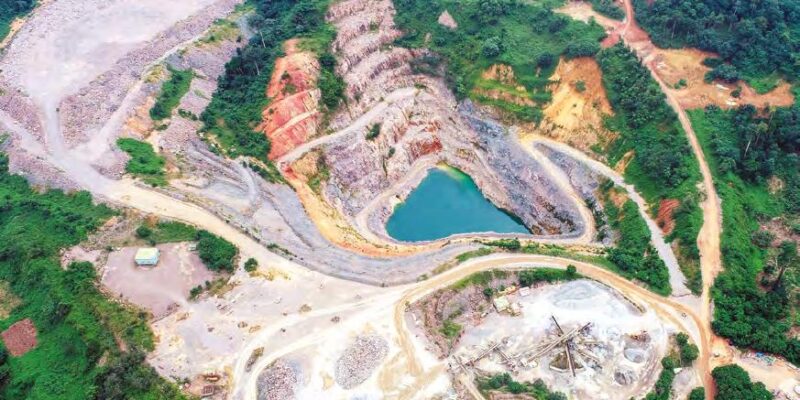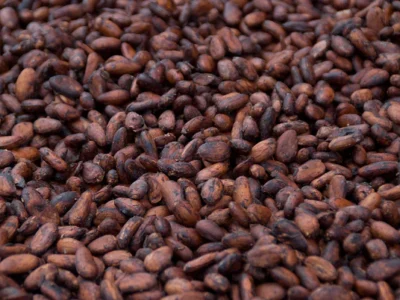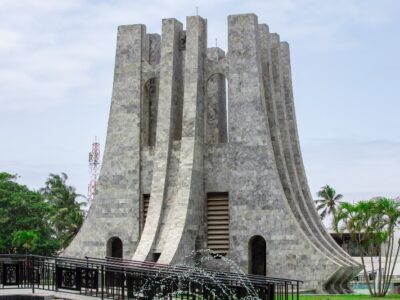Ghana has abundant mineral resources that have been mined for centuries. Apart from the major minerals – gold, diamonds, manganese, and bauxite – Ghana also has confirmed deposits of iron ore, copper, chrome, nickel, limestone and quartz, which are at varying stages of development. The sector is dominated by larger foreign operators, although the government retains a 10 per cent carried interest in most of the active large-scale mining activities. Small-scale mining is however reserved for Ghanaians by law. The mining industry consistently contributed above 7 per cent of Ghana’s GDP from 2018 to 2020 but this dropped significantly to 5 per cent due to the reduction in the production of gold and bauxite in 2021. In 2020, the sector was the fourth-largest contributor to the country’s annual gross production behind crop production, manufacturing, and trade.
mining sector recorded a 60 per cent jump between 2018 and 2019 due to the increase in commodity prices. In 2020, the mining industry contributed 18.12 per cent of total revenue collected by the Ghana Revenue Authority (GRA). This included a 5 per cent mineral royalty on the total revenue earned from mining operations that operators pay to GRA every year. Leading multinational operators such as Newmont Goldcorp, AngloGold Ashanti and Gold Fields operate production sites in the country, including Obuasi, Iduapriem (Tarkwa), Damang, Prestea, Bogoso, Wassa, Kenyasi, Akyem, Chirano, Teleku Bokazo, Kwabeng and Osino. Gold Fields Ghana was the highest-producing gold company in 2021, producing 521,688 ounces of gold, which was a 0.87 per cent decrease from the previous year.

In 2021, Ghana had a total output of 129 tonnes and was the top producer of gold in Africa, ahead of South Africa and Burkina Faso. Gold accounted for 96 per cent of all mining export revenue in that same year. Revenue from the
Bauxite has been mined in Ghana since 1914 but it was in 2017 that the highestever output of 1.1 million tonnes was recorded. Currently, most mining takes place in Awaso, where the Ghana Bauxite Company, a joint venture between the government of Ghana and a consortium of investors who hold an 80 per cent stake, operates. Apart from Awaso, there are deposits at Kyebi, Nyinahin and Ejuanema. Ghana does not have any bauxite refineries or an integrated aluminium industry and the majority of it is exported to Canada and Scotland for refining into alumina. However, the Volta Aluminum Company’s alumina smelter is able to meet the majority of local demand. Ghana currently hosts all major production steps in aluminium processing, however, VALCO imports alumina for processing into aluminium, despite Ghana’s large bauxite reserves. The government has signed a memorandum of understanding with China for the development of some of the bauxite reserves that is expected to present huge growth opportunities in the sector.
Diamond mining in Ghana is mainly undertaken in the Birim Valley, near Akwatia in the Eastern Region, typically by small-scale miners, from alluvial as well as in-situ deposits. Ghana is not among the list of top global producers, although it has several deposits of diamonds. The main miner of diamonds is the now state-owned Ghana Consolidated Diamonds Limited (GCDL), which operates in the Birim River basin. Ghana produced a little over 25,000 carats of rough diamonds in 2020, a major reduction in diamond production that has been attributed to the closure of the Akwatia mine about ten years ago and the curbs on small-scale mining in the effort to stamp out ille- gal miners. Diamonds from Ghana are mostly exported to Belgium and the Netherlands.
Manganese ore production began in 1914, when it was discovered in NsutaWassa in the Western Region. Currently, the Ghana Manganese Company, which is jointly owned by Consolidated Minerals Africa Limited, a private firm controlling a 90 per cent stake, and the government of Ghana, which owns the other 10 per cent, has a mining concession covering 170 square kilometres in and around Nsuta. Only about 3 per cent of the concession has been mined to date. Manganese is used in the production of steel and batteries, as well as the water treatment industry, the production of micronutrients to produce fertilisers, and the creation of different colour pigments in the production of paints. The major importers of manganese as of 2020 were China, India, Norway, Russia, and South Korea.
The Ministry of Lands and Natural Resources is responsible for the sector and is mandated to promote efficient management and sustainable use of the country’s resources. The Minerals Commission, Lands Commission and Environmental Protection Agency are some of the regulatory and enforcement agencies under the ministry.
Sector Incentives
• Mining companies get concessionary rates for the import of plant, machinery and equipment meant specifically for mining
• Mining companies enjoy a capital allowance of 20 per cent straight line on their mining assets for 5 years and an investment allowance of 5 per cent in the first year
Sector Opportunities
• Establishment of new bauxite mines and refineries
• Opportunities to partner with Ghana Integrated Iron and Steel Development Corporation to tap into the 6 billion metric tonnes of iron ore deposits in the country
• Investment in or partnership with Ghana Consolidated Diamonds Limited (GCDL) to improve and sustain production at the Akwatia mine
• Establishment of an aluminium smelter to complement the work of VALCO, which operates the only smelter in the country. ■TG
Gold Fields Ghana Foundation gets new look

Over 20 years of investing in our communities, their dreams and their future
Stakeholder value creation is one of Gold Fields’ six ESG priorities and the Gold Fields Ghana Foundation is the entity that is spearheading the delivery of the company’s target by 2030.
In 2023, the Foundation’s Board of Trustees approved the restructuring of the Foundation. A secretariat was established to manage the operations and activities of the Foundation, which were previously handled by the Community Affairs Managers of the company’s Tarkwa and Damang mines in the Western Region.
How it all started
Gold Fields Ghana established the Community Development Fund in 2002 to fund socio-economic development projects and programmes in the host communities. In 2004, the fund was officially registered as the Gold Fields Ghana Foundation. The Foundation has a formalised governance structure and funding mechanism and is the first to be set up by a mining company in Ghana.
Revamping for better
The trustees had one purpose in mind when they decided to reform the Foundation – that is to improve the delivery of its mandate, which is to ensure that the communities impacted by the mines’ operations benefit from the value created. Streamlining operations under a single, semi-autonomous management was the most effective way to achieve this objective. Headed by the Executive Secretary, the secretariat now manages all activities of the Foundation. It ensures that all approved development and livelihood enhancement programmes and projects for stakeholder communities are delivered promptly and are of approved standard.
The Foundation is governed by a seven-member Board, constituting the General Managers of the Tarkwa and Damang mines, the Chief Executive Officer of the Ghana Chamber of Mines, a representative of the Gold Fields Board, members of Parliament for the TarkwaNsuaem and Prestea Huni-Valley constituencies, and the Executive Vice President and Head of Gold Fields West Africa, who is also the chair. The Board reviews and approves all projects, budgets and expenditures. However, projects to be undertaken are determined by members of the mines’ 19 host communities. This is done through a comprehensive consultative process involving chiefs, opinion leaders, youth and women groups, unit committee heads, members of the district assemblies, representatives of government agencies and members of the respective communities. This bottom-up approach ensures that only relevant projects that address key community needs are undertaken and guarantees a strong community ownership.
Creating enduring value beyond mining
Since 2004, the Foundation has invested over US$ 96.38m in socio-economic development programmes and projects, focusing on education, health, water and sanitation, agriculture and infrastructure. Some of these include scholarships, Youth in Horticulture Production (YouHoP), cocoa farmers support programme, community apprenticeship, graduate training, provision of potable water, as well as construction of roads, schools and clinics.

In recent years, the Foundation has shifted its focus to shared value projects that have measurable and sustainable impacts on stakeholder communities. Some of the flagship projects include:
• A 10,400-capacity international standard stadium in Tarkwa. When completed, the stadium is expected to open up the town for sporting and economic activities.

• A 360-bed girls’ dormitory for the Huni Valley Senior High School and four apartments for teachers. US$980,000 was invested in this project, which has eased accommodation challenges in the school.


• A 33km Tarkwa-Damang public road, a US$27m project that has eased transportation and improved road safety.

Keeping the coffers flowing
Funding for the Foundation is primarily through contributions from the Tarkwa and Damang mines, based on their production profitability. For every ounce of gold produced by the mines, one US dollar is donated to the Foundation, in addition to 1.5% of the mines’ profits before tax (US$1/oz plus 1.5% of pretax profit). This is an agreed funding formula, which ensures that the developmental needs of the host communities are directly tied to those of the mines. The financial accounts of the Foundation are audited annually by an independent financial auditor.
Visit www.goldfields-ghana.com to learn more about how the Gold Fields Ghana Foundation is sharing the value of gold with stakeholder communities.

@ghanagoldfields
@GoldFields_LTD linkedin.com/company/gold-fields
@goldfields_ltd
@goldfields-ghana.com














Comments